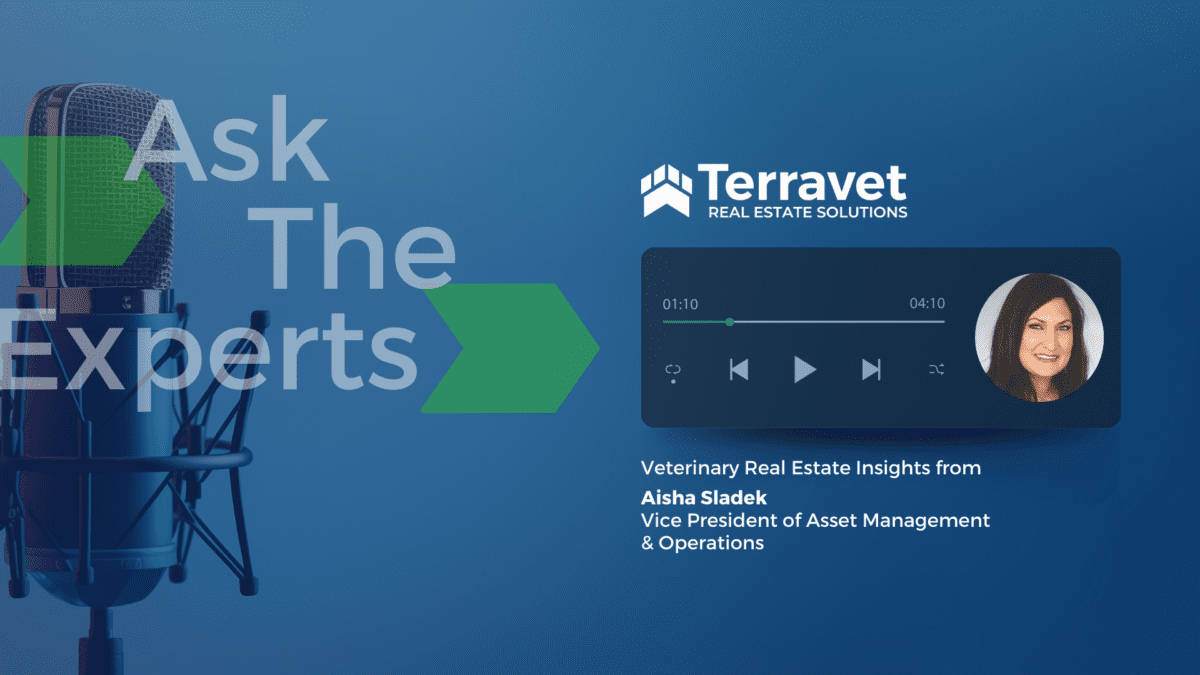The veterinary industry is evolving rapidly, and so is the real estate that supports it. To better understand the shifting landscape, we sat down with Aisha Sladek, Vice President of Asset Management & Operations at Terravet, for veterinary real estate insights and to discuss the challenges and opportunities in veterinary real estate today.
Aisha’s experience in asset management has given her valuable insights into the transformation of veterinary facilities; from small, converted houses to modern, state-of-the-art hospitals. In our conversation, she shared these key insights into asset management; including evolving veterinary needs and the trends shaping the industry in 2025 and beyond.
What does asset management mean in veterinary real estate?
Asset management in veterinary real estate is about much more than maintaining properties. As Aisha explains, it’s about ensuring that veterinary hospitals can operate efficiently while also increasing property value for investors.
Most of these leases are triple net, meaning that while tenants handle things like taxes, insurance, and property maintenance, the landlord is responsible for structural elements like the roof and foundation. But Terravet’s role doesn’t stop there—they actively collaborate with tenants on property improvements, expansions, and renovations to ensure facilities meet modern veterinary needs.
Real estate insights: adapting to the evolving needs of veterinary professionals and their clients
One of the biggest shifts in the industry has been the increasing demand for larger and more specialized veterinary spaces. With approximately 70% of U.S. households now owning pets, veterinary facilities must scale up to meet growing patient volumes. Aisha notes that older, house-style clinics are giving way to expansive, high-tech hospitals that accommodate advanced services such as cardiology, oncology, and rehabilitation.
This shift isn’t just about pet care, it’s also about the professionals delivering it. With labor shortages affecting the veterinary field, practices are turning to technology and improved workspaces to attract and retain top talent. Investing in comfortable, efficient, and well-equipped facilities is no longer a luxury but a necessity for veterinary real estate owners.
Key trends in veterinary real estate for 2025 and beyond
With corporate practice acquisitions slowing, many veterinary groups are focusing on upgrading their existing hospitals rather than acquiring new ones. More funding is being allocated to renovations that improve workflow and enhance the client experience.
Read our latest blog on veterinary real estate market trends for 2025.
Veterinary hospitals are incorporating automation and digital tools to combat staffing shortages and streamline workflows. Smart building designs that integrate these technologies will become a key factor in real estate decisions.
Geographically, while major cities have seen substantial veterinary expansion, smaller towns and suburban areas are becoming new growth markets. Aisha highlights that working with hospitals across the country has reinforced the need for high-quality veterinary care in traditionally underserved regions. As a result, veterinary real estate development is expanding into these areas to meet the rising demand.
Watch the full interview now to gain valuable veterinary real estate insights.
Real estate as a tool for veterinary success
Veterinary real estate isn’t just about buildings, it’s about creating environments that support the future of pet care. As Aisha puts it, “The most rewarding part of my role is knowing that I’m helping people who, in turn, are helping others.” By addressing hospital operators’ real estate needs, Terravet enables veterinary professionals to focus on delivering quality care without disruptions.
“The most rewarding part of my role is knowing that I’m helping people who, in turn, are helping others.”
As a trusted buyer—not a veterinary real estate broker—Terravet partners with veterinary professionals to find long-term real estate solutions that work for both their business and their patients. Whether it’s expanding an existing facility, modernizing outdated spaces, or acquiring strategic properties, Terravet’s focus is on investment and improvement, not brokerage services.
The veterinary industry continues to grow, and with that, its real estate. The insights Aisha shares offer a valuable perspective for practice owners, investors, and veterinary professionals looking to stay ahead of industry shifts.
For a deeper dive into these trends and expert insights, watch our full interview with Aisha Sladek, where she discusses the future of veterinary real estate and how Terravet is helping shape the industry.



